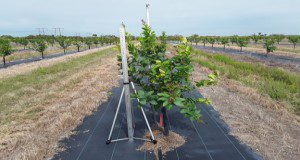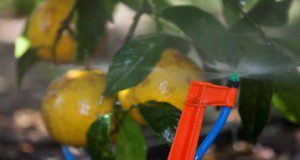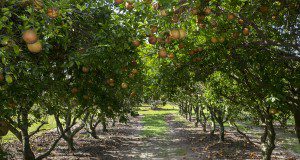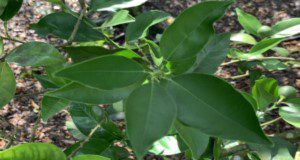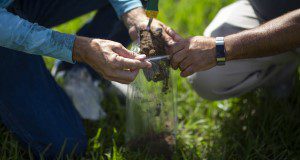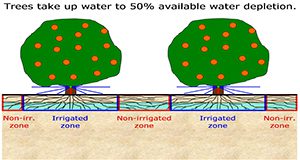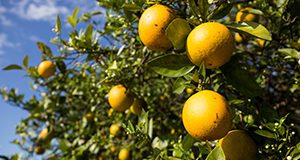Young citrus trees require optimal irrigation management for vigorous vegetative growth, leaf flushing, and establishment of a dense canopy. Poor irrigation practices, such as infrequent irrigation or irrigating without using irrigation scheduling tools, could be costly. Besides excessive loss of water and nutrients, the growth of young trees might be impacted by an excess or deficit of water. Crop water stress in young trees directly affects yield and fruit quality. This new 2-page publication of the UF/IFAS Department of Soil and Water Sciences, written by Davie Kadyampakeni and Sandra Guzmán, covers some strategies for optimizing young tree care and irrigation management to in turn optimize grove efficiency and productivity.
https://edis.ifas.ufl.edu/ss701
Tag: Davie Kadyampakeni
Nutrition and Irrigation Management for Florida HLB-Affected Trees
To improve production of huanglongbing (HLB) affected trees, nutrition, irrigation, and soil pH should be considered together, because each can influence the efficacy of the others in overcoming the effects of HLB on tree performance. This two-sided poster published by the UF/IFAS Horticultural Sciences Department through the UF/IFAS Citrus Research and Education Center was written by Tripti Vashisth, Davie Kadyampakeni, and Jamie D. Burrow.
https://edis.ifas.ufl.edu/hs1367
Nutrition of Florida Citrus Trees, Third Edition
This update to 2007’s second edition adds information regarding nutrition of Florida citrus trees affected by huanglongbing (HLB), also known as citrus greening. Much of the guidance provided in this document on nutrients, application methods, leaf and soil sampling, and irrigation scheduling is also effective for trees affected by HLB. However, research conducted since the previous edition was published has established changes in many production practices, including nutrient rates, irrigation scheduling, soil pH management, and use of Citrus Under Protective Screen (CUPS). Changes to the second edition will appear at the beginning of chapters 2, 6, 8, 9, and 11. See also this topic page for links to individual chapters in HTML and PDF formats. This 115-page book was edited by Kelly T. Morgan and Davie M. Kadyampakeni, and published by the UF/IFAS Department of Soil and Water Sciences.
https://edis.ifas.ufl.edu/ss478
Citrus Leaf Sampling Procedures for Nutrient Analysis
To maintain balanced nutrients for optimal tree growth, citrus growers need to assess trees’ nutritional requirements. These assessments help prevent any nutrient deficiency or toxicity from compromising tree health and yield or reducing revenue. This new illustrated two-page instructional sheet gives a basic procedure for the citrus leaf sampling process, as well as additional suggestions for HLB-affected trees. Written by Tripti Vashisth, Jamie D. Burrow, Davie Kadyampakeni, and Rhuanito S. Ferrarezi, and published by the UF/IFAS Horticultural Sciences Department.
https://edis.ifas.ufl.edu/hs1355
Soil Sampling Procedures
To achieve optimal grove nutrition, citrus growers must test grove soil before beginning any fertilization program. Standard procedures for sampling, preparing, and analyzing soil should be followed for meaningful interpretations of the test results and accurate recommendations. This new two-page fact sheet, published by the UF/IFAS Department of Soil and Water Sciences, provides illustrated soil sampling procedures and tables to aid in basic interpretation of lab results. Written by Davie Kadyampakeni, Kelly Morgan, Arnold Schumann, and Rhuanito S. Ferrarezi.
https://edis.ifas.ufl.edu/ss667
Irrigation Management of HLB-Affected Trees
Water is a limiting factor in Florida citrus production due to non-uniform rainfall distribution and the low water-holding capacity of our sandy soils. Because periods of low rainfall coincide with critical stages of citrus production, additional irrigation is necessary to reduce the negative effects of water stress. This 6-page document covers recent findings on water use of trees affected by citrus greening and the impact this would have on irrigation management considerations. Written by Davie Kadyampakeni, Kelly Morgan, Mongi Zekri, Rhuanito Ferrarezi, Arnold Schumann, and Thomas A. Obreza and published by the UF/IFAS Department of Soil and Water Sciences, October 2017.
http://edis.ifas.ufl.edu/ss659
Citrus Irrigation Management
 The chapter on irrigation management of citrus is largely taken from guidelines provided in SL253 on trees prior to Huanglongbing (HLB) prevalent conditions. A section has been added to cover recent findings on water use of trees affected by HLB and the impact this would have on the irrigation management considerations. This 6-page fact sheet discusses water supply, allowable soil water depletion, irrigation scheduling, soil moisture measurement, water budgeting, smartphone apps, irrigation strategies to improve nutrient uptake and reduce leaching, and irrigation management considerations for HLB-affected trees. Written by Davie Kadyampakeni, Kelly Morgan, Mongi Zekri, Rhuanito Ferrarezi, Arnold Schumann, and Thomas Obreza, and published by the UF/IFAS Soil and Water Sciences Department, September 2017.
The chapter on irrigation management of citrus is largely taken from guidelines provided in SL253 on trees prior to Huanglongbing (HLB) prevalent conditions. A section has been added to cover recent findings on water use of trees affected by HLB and the impact this would have on the irrigation management considerations. This 6-page fact sheet discusses water supply, allowable soil water depletion, irrigation scheduling, soil moisture measurement, water budgeting, smartphone apps, irrigation strategies to improve nutrient uptake and reduce leaching, and irrigation management considerations for HLB-affected trees. Written by Davie Kadyampakeni, Kelly Morgan, Mongi Zekri, Rhuanito Ferrarezi, Arnold Schumann, and Thomas Obreza, and published by the UF/IFAS Soil and Water Sciences Department, September 2017.
http://edis.ifas.ufl.edu/ss660
Fertigation for Citrus Trees
Microirrigation is an important component of citrus production systems in Florida. For citrus trees, microirrigation is more desirable than other irrigation methods for several reasons: water conservation, fertilizer management efficiency, and freeze protection. Research has shown that when microirrigation systems are properly managed, water savings can amount to as much as 80% compared with subirrigation and 50% compared with overhead sprinkler irrigation. Research has also shown the important advantage of microsprinklers for freeze protection of citrus. This 4-page fact sheet discusses fertilizer solubility and some common fertigation materials. It also offers a fertigation summary. Written by Mongi Zekri, Arnold Schumann, Tripti Vashisth, Davie Kadyampakeni, Kelly Morgan, Brian Boman, and Tom Obreza, and published by the UF Horticultural Sciences Department, September 2017.
http://edis.ifas.ufl.edu/hs1306
